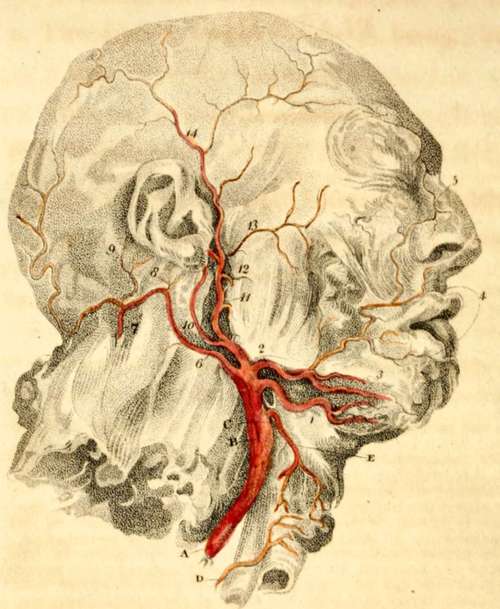Carotid Artery
Description
This section is from the book "Engravings Of The Arteries", by Charles Bell. Also available from Amazon: Engravings Of The Arteries; Illustrating The Anatomy Of The Human Body, And Serving As An Introduction To The Surgery Of The Arteries.
Carotid Artery
This and the following Plate illustrate the Text of Bell, from pages 242—294; and Wistar, pages 241—254.
a. The Common Carotid Artery.*
* To cut down for this artery, I would turn the chin towards the same side, and then make an incision two inches and a half in length along the anterior edge of the sternoid portion of the cleido mastoideus. In doing this, the firm cellular membrane, and some of the anterior fibres of the platysma myoides must be cut. Having fairly laid bare the edge of the mastoideus, we ought to do no more with the edge of the knife; we ought then to hold aside the mastoideus, and, with the fingers and handle of the knife, we dig down to the artery, and insulate it: We find a small muscle, the omo-hyoideus passing obliquely over the artery, about an inch and a half from the head of the clavicle. The great internal jugular vein is close on the outside of the artery, the par vagum betwixt them, the sympathetic nerve below, and close upon the vertebrae. If a small nerve be observed running above the artery, it is the descendens noni.

b. The Internal Carotid Artery, or Artery of the Cerebrum.*
c. The External Carotid Artery.
d. The Lower Thyroid Artery, being a branch of the Subclavian Artery.+
e. The Upper Thyroid Artery, being the first branch of the Carotid. ++
If vessels bleed in making this incision, they are muscular branches of the thyroid artery.
* Internal Carotid lacerated.—Abernethy's Surg. Obs.
+ The Inferior Thyroid lies in a situation not to be tied. It lies near the side of the vertebrae, where it is, on the outer side of the carotid artery, fully five fingers breadth from the clavicle. It should be sought for directly under the omo-hyoideus, and betwixt the carotid and the anterior edge of the scaleni. It cannot be taken up there. In cutting for it, I cut the sympathetic, and probably the phrenic nerve. It would be better to endeavour to reach the artery, by turning over the side of the gland which lies before the carotid trunk. By thus stretching the gland, we find the artery as if descending from above, in two branches, to the lower part of the gland.
++ It may be proposed, previous to the attempt of extirpating the thyroid gland, to tie the four arteries which supply it. We cannot reach the inferior thyroid artery before it has passed under the carotid: The only possible way is, to lift up the inferior lobe of the tumour, separating the carotid from it; when we find the inferior thyroid artery rising in two branches, to be distributed to the gland. It would appear that these branches were descending from the carotid, by the acute turn they take downwards from their highest point on the neck.
Continue to:
- prev: Diaphragm, the Situation of the Heart, the Blood-vessels of the Breast, and the Abdominal Aorta
- Table of Contents
- next: Branches Of The External Carotid Artery
